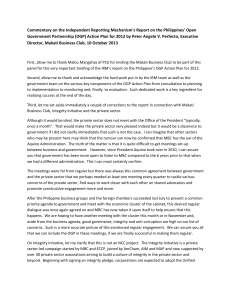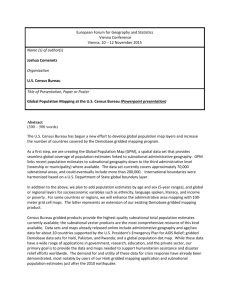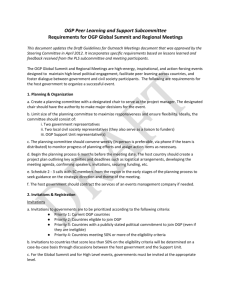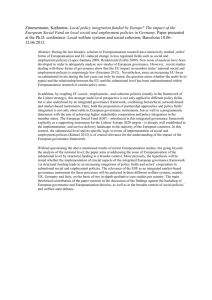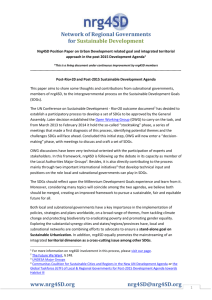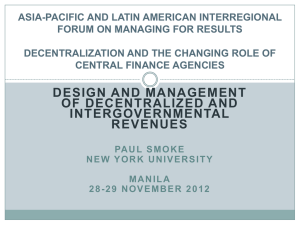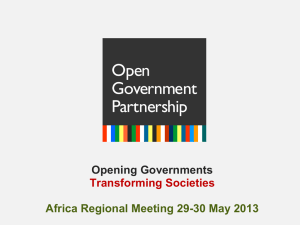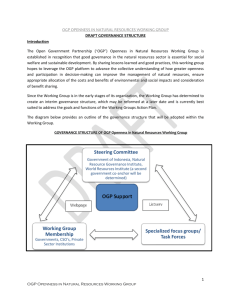“issues and options” paper - Open Government Partnership
advertisement
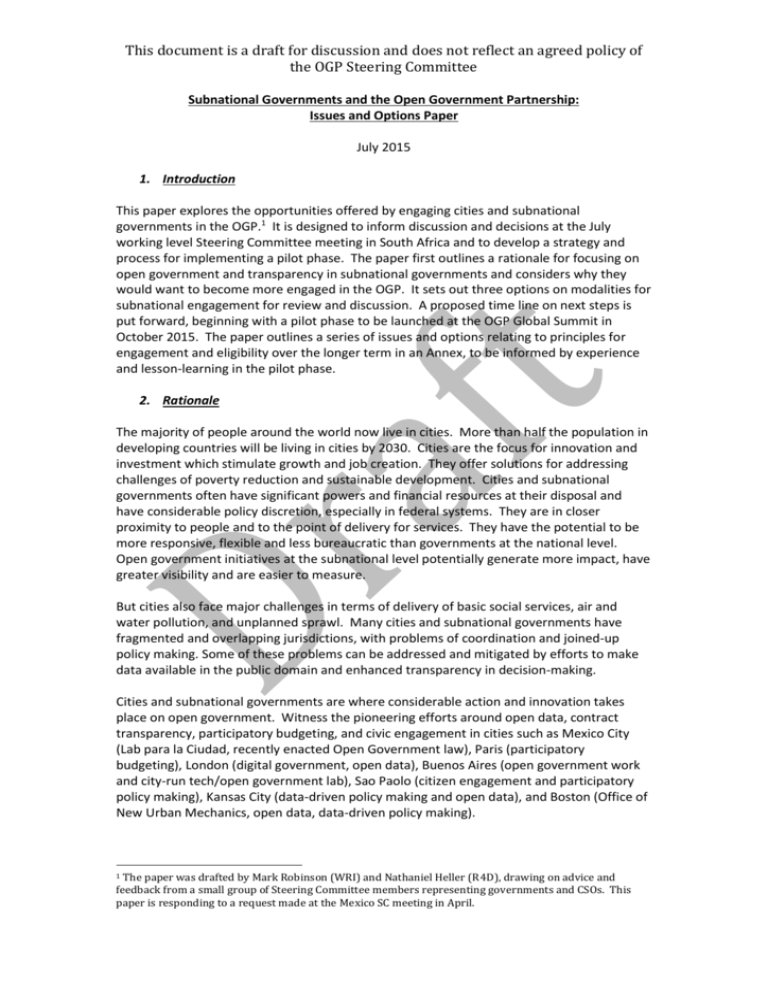
This document is a draft for discussion and does not reflect an agreed policy of the OGP Steering Committee Subnational Governments and the Open Government Partnership: Issues and Options Paper July 2015 1. Introduction This paper explores the opportunities offered by engaging cities and subnational governments in the OGP.1 It is designed to inform discussion and decisions at the July working level Steering Committee meeting in South Africa and to develop a strategy and process for implementing a pilot phase. The paper first outlines a rationale for focusing on open government and transparency in subnational governments and considers why they would want to become more engaged in the OGP. It sets out three options on modalities for subnational engagement for review and discussion. A proposed time line on next steps is put forward, beginning with a pilot phase to be launched at the OGP Global Summit in October 2015. The paper outlines a series of issues and options relating to principles for engagement and eligibility over the longer term in an Annex, to be informed by experience and lesson-learning in the pilot phase. 2. Rationale The majority of people around the world now live in cities. More than half the population in developing countries will be living in cities by 2030. Cities are the focus for innovation and investment which stimulate growth and job creation. They offer solutions for addressing challenges of poverty reduction and sustainable development. Cities and subnational governments often have significant powers and financial resources at their disposal and have considerable policy discretion, especially in federal systems. They are in closer proximity to people and to the point of delivery for services. They have the potential to be more responsive, flexible and less bureaucratic than governments at the national level. Open government initiatives at the subnational level potentially generate more impact, have greater visibility and are easier to measure. But cities also face major challenges in terms of delivery of basic social services, air and water pollution, and unplanned sprawl. Many cities and subnational governments have fragmented and overlapping jurisdictions, with problems of coordination and joined-up policy making. Some of these problems can be addressed and mitigated by efforts to make data available in the public domain and enhanced transparency in decision-making. Cities and subnational governments are where considerable action and innovation takes place on open government. Witness the pioneering efforts around open data, contract transparency, participatory budgeting, and civic engagement in cities such as Mexico City (Lab para la Ciudad, recently enacted Open Government law), Paris (participatory budgeting), London (digital government, open data), Buenos Aires (open government work and city-run tech/open government lab), Sao Paolo (citizen engagement and participatory policy making), Kansas City (data-driven policy making and open data), and Boston (Office of New Urban Mechanics, open data, data-driven policy making). The paper was drafted by Mark Robinson (WRI) and Nathaniel Heller (R4D), drawing on advice and feedback from a small group of Steering Committee members representing governments and CSOs. This paper is responding to a request made at the Mexico SC meeting in April. 1 This document is a draft for discussion and does not reflect an agreed policy of the OGP Steering Committee There is increasing interest in and support from city and subnational governments in formally engaging with OGP, joining the ranks of public sector innovators who are pushing the boundaries of reimagining the government-civil society paradigm, and who are willing to share their experience with others. OGP national governments have an opportunity to engage city and subnational governments in order to learn from the innovations and experimentation taking place in these jurisdictions, and similarly cities and subnational governments can learn from national-level open government initiatives. A number of National Action Plan plans already contain subnational government commitments; a total of 73 commitments have been made out of 1,894 commitments to date, representing a little under 4% of the total, with Brazil, Mexico and Macedonia each having more than 5 commitments at the subnational level. 3. Incentives for subnational government engagement Engaging subnational governments and civil society organizations in OGP increases international exposure and visibility for reform-minded mayors, governors, and local civil society leaders. Many of these subnational governments and their civil society counterparts aspire to be global actors pioneering local solutions to global problems through international networks, especially on issues such as climate change and pollution. Cities and subnational governments share a common interest in delivering basic services to their residents in an efficient and equitable manner – water, waste management, access to quality health care – and learning lessons from efforts to improve data access and transparency. Using OGP to provide government and civil society reformers with space and visibility offers them a potentially powerful force multiplier for their work. OGP can provide strong institutional support to boost existing subnational open government initiatives. CSOs working on open government and transparency in cities and subnational jurisdictions could also receive a major boost from the engagement of subnational governments in OGP. Rather than having to rely primarily on international partners to gain exposure on the international stage, OGP would allow these entrepreneurial CSOs to access a global audience for their work as well as opportunities for lesson-learning across national boundaries. Subnational governments could use the opportunity of becoming part of OGP to benefit from a peer-to-peer learning experience with other mayors/government figures, domain experts, and civil society organizations championing similar open government projects. There is no existing network of open government reformers at the sub-national level, whether domestically in key OGP countries or at the international level, across countries. Extending the opportunity to subnational governments to engage in OGP could help them build minimum conditions and strengthen capacities to follow through and implement OGP principles of transparency, access to information, accountability, and citizen engagement in their open government initiatives. A move to include subnational governments and civil society leaders offers OGP with a ready-made pipeline of future national and international leadership. Many national political leaders begin their careers as subnational political leaders. The earlier they are exposed to and embrace key OGP principles, the more likely they will be to step up to positions of OGP leadership later in their careers. Mexican President Enrique Pena Nieto was first the governor of the State of Mexico before becoming President of the Republic. French Prime Minister Francois Hollande was Mayor of Tulle from 2001-2008. Brazilian president Dilma Rousseff began her career as a political leader in the state of Rio Grande do Sul and the city of Porto Alegre (the birthplace of participatory budgeting). Investing in subnational This document is a draft for discussion and does not reflect an agreed policy of the OGP Steering Committee champions now offers OGP a rich downstream pipeline of future open government leadership, a potentially invaluable return on investment. Regardless of the progress that some subnational governments have shown on open government initiatives, the level of understanding of the concept generally remains low at the local level. Open government might continue as a niche or secondary activity for many government officials at the subnational level without the opportunity to engage in and draw inspiration from the OGP. By engaging in the OGP, subnational government leaders can advance open government efforts, creating opportunities for replication and a source of inspiration for subnational entities in different countries. Open government leaders in cities and regional governments can serve as beacons to inspire others and provide a focus for civil society efforts in support of these issues. However, growing interest and engagement in open government and transparency on the part of subnational governments may not be sufficient reasons to widen participation in the OGP. The present focus of the OGP continues to be on widening engagement of national governments and deepening national open government commitments and outcomes. This is already a demanding agenda and one that has considerable merit. Some may hold the view that the value added of expanding the OGP to different levels of government may not be greater than securing better commitments at the national level in pursuit of open government goals. 4. A phased approach to subnational government engagement in OGP Below is a proposed sequence of phases for how we may take forward engagement of subnational governments: Phase 1: Stand-alone pilot phase. We propose in the short-term (over a one year period leading up to the Paris summit) to start with a limited number of open government commitments and initiatives during an initial experimental, pilot period. This could be limited to a small number of city governments that are already leaders and innovators on open government. Phase 2: Integration into National Action Plans. In the second phase, we would aim to integrate subnational commitments more systematically into National Action Plans and promote lesson-learning across subnational governments. National governments in the US and UK have begun to experiment with this through their third NAPs, and this could be explored with other participating governments where there is good practice with local stakeholder engagement. National governments could encourage the inclusion of subnational open government practices, and/or facilitate sharing of best practices, experiences and lessons learned among and between subnational governments. Phase 3: Full integration of subnational governments into OGP. If the above efforts are successful, we could move towards inclusion of subnational governments into OGP. This would be a major change and require a revision of the OGP Articles of Governance. Some considerations to inform this course of action over the longer term are presented in the Annex. Preliminary feedback from subnational government working group members (Brazil, Mexico, UK, and the US) and staff of the Support Unit points to strong support for Phase 1, namely a This document is a draft for discussion and does not reflect an agreed policy of the OGP Steering Committee short-term pilot phase, as a priority. This is outlined in more detail in the next section. The proposed phased approach, along a continuum from less to more radical revisions of OGPs current structure, would have the additional benefit of permitting evaluation of the many complex factors that should be taken into account as OGP evolves to engage at the subnational level, while also permitting the Support Unit to grow its resource base commensurate with the new demands it would be facing. 5. Outline of Phase 1 – stand-alone pilot phase The following proposal for a pilot phase should be subject to review and discussion in the July working level Steering Committee meeting for subsequent endorsement by the full OGP Steering Committee in October as the basis for initiating this phase. These initial proposals will require further elaboration following the July SC meeting once the overall approach is agreed. Beyond the options listed below, an ad hoc subnational government task force should be created to work on the specific criteria and standards for taking forward the subnational eligibility and evaluation processes, and to guide any other decisions or intervention required by the full Steering Committee. The objective of the pilot phase would be to (i) provide leading local reformers a global platform to highlight their work and share experience with others, (ii) provide OGP countries and civil society better visibility and inspiration from those programs, and (iii) learn lessons to inform decisions on whether to proceed and if so, how to structure phase 2. The fundamental aim of the pilot phase is to explore whether pilot subnational open government commitments (and the processes used to develop them) meet or exceed OGP national commitments in terms of (i) their ambition and level of specificity, (ii) the degree to which these pilot commitments are jointly developed by subnational governments and counterpart CSOs, and (iii) their complementarity or differences with existing national OGP commitments. If we conclude the initial pilot phase with a series of subnational commitments that meet or exceed what we expect to see from OGP national governments, this would provide confirmation that subsequent phases would merit consideration. A key output of this phase would be 1-2 commitments or projects per city/subnational entity, in which core OGP principles apply to the development of those commitments (e.g. developed jointly with civil society, aspiring for ambitious commitments with clear and measureable outcomes). Key elements to be considered in designing this pilot phase over a period of 15-18 months might include the following: i. ii. iii. iv. Begin by selecting a small number of cities in OGP countries (8-10 initially) from all regions, subject to an agreed population minimum, in consultation with SC members and national governments; Prioritize cities with existing and ambitious commitments to open government as among the first to be included; Build on a shortlist of city governments identified by the Government of Mexico for the Guadalajara summit, including representatives from Asia and Africa; Start with a small number of subnational open government innovations for showcasing in the Guadalajara summit, complemented by a high-profile plenary session with a selection of well-known current or former mayors and governors; This document is a draft for discussion and does not reflect an agreed policy of the OGP Steering Committee v. Engage local CSOs to validate, monitor and document the pilot phase based on partnerships with local governments and the private sector (with light-touch guidance from Independent Review Mechanism). These design principles could be complemented by a series of learning mechanisms along the following lines: i. Use the subnational government task force to facilitate peer learning and exchange on open government practices at the subnational level. ii. Use webinars, regional meetings, and other peer learning vehicles to facilitate exchange of practices, knowledge and lessons learned at the subnational level. iii. Incorporate evaluation of subnational uptake and results in OGP’s research and knowledge management agenda. iv. Develop an OGP Award for subnational engagement processes, commitments and implementation. vi. Explore other ways to incentivize subnational engagement processes, commitments and implementation at the national level. vii. Develop partnerships with government networks and CSOs working on subnational and city governance issues to widen engagement in OGP. v. Develop, host and facilitate a network of stakeholders involved in open government at the subnational level (similar to the network approach championed by Mexico in the Western Hemisphere). vi. Facilitate donor support for subnational open government practices and exchange of experiences, best practices and lessons learned. 6. Proposed next steps Subject to agreement on the preferred option, this section sets out the proposed next steps in the process, from the SC meeting in Johannesburg through to the SC meeting in Mexico in October and pilot phase implementation. SC meeting, July 2015, Johannesburg, South Africa Confirm or adjust the proposed phase approach outlined in section 4. Develop a timeline for designing, implementing, and learning from an initial pilot phase of OGP’s new subnational mechanism. Create a subnational government task force comprising SC members and a few subnational government officials to provide guidance on the design and implementation of a pilot phase for full SC endorsement at the Mexico global summit. UNGA meeting, September 2015, New York City Brief OGP Steering Committee ministers participating in the UNGA meeting on progress towards a subnational pilot and solicit ministerial input towards a final proposal. OGP Global Summit, October 2015, Guadalajara, Mexico Seek agreement and endorsement from the full Steering Committee on an updated subnational engagement strategy for OGP This document is a draft for discussion and does not reflect an agreed policy of the OGP Steering Committee Invite up to 10 leading city and subnational governments that are leaders in open government to the October summit to celebrate the launch of OGP’s pilot subnational program. Based on the decisions on the parameters of a pilot phase, these subnational governments should ideally be selected to include a number of the known open government innovators at the city level in OGP countries, building on a list being developed by the Government of Mexico. Aim for a high-profile plenary session and announcement on subnational and city engagement in the OGP at the Mexico summit with a selection of well-known current or former mayors and governors and some sort of professionally facilitated presentation of their successes and challenges to date in open government. Post-Summit opportunities Official launch of OGP’s pilot subnational program (Phase 1) in January 2016, to be developed following the discussions and decisions in the October summit. Develop timeline for implementation of the pilot phase leading to the Paris summit in early-2017. Showcase leading results from examples of open government innovations from 8-10 cities in the pilot phase. Make decision on longer-term engagement of subnational governments at the ministerial level SC meeting to take place at or around the Paris summit. This document is a draft for discussion and does not reflect an agreed policy of the OGP Steering Committee ANNEX: Subnational governments and Open Government Partnership – Longer term considerations During the course of the pilot phase some consideration will need to be given to how best to engage subnational governments and CSOs in the OGP over the longer-term. The following issues would need to be addressed at a later stage and be informed by experience with implementation of the pilot phase: i. ii. iii. iv. v. vi. Develop principles for engagement, eligibility criteria and metrics; Clarify governance role of subnational governments in OGP; Specify types and scope of subnational commitments and development of action plans; Evaluate implementation plans, and costs and methods of monitoring and evaluation; Propose coordination arrangements with the SC and other OGP governance bodies); Develop administrative priorities, funding requirements and review procedures within the OGP Support Unit. We address the first four of these in detail below. The fifth area requires careful consideration and will depend on the lessons from the pilot phase and decisions on prospective scale-up. (i) Principles for engagement There are three main considerations that would need to be taken into account when evaluating the options for engaging sub-national governments in OGP. Principle 1: Subnational governments and cities should only be eligible to join OGP if their national governments are also OGP signatories. If subnational governments were permitted to register independently of national OGP participation, this would risk bypassing national governments by creating a separate track for engagement, and the process of registering interest and validation could become unmanageable. A separate track also risks potential conflict with national governments, for example where they are governed by competing political parties. The design of OGP eligibility requirements for subnational governments should therefore avoid the possibility of national governments exercising veto power in situations where subnational governments meet the minimum OGP eligibility criteria but are governed by leadership with agendas that differ from those of their counterparts in national government. Principle 2: Participating subnational and city governments should follow the same basic rules and timing and adhere to the same principles and norms as national OGP governments. Subnational governments should embrace the OGP Declaration; they should meet OGP eligibility criteria (options discussed below); they should develop open government commitments in collaboration with subnational civil society organizations; and they would submit to independent peer review assessments based on the approach used by the IRM. Principle 3: Over time, subnational governments should be able to acquire some formal status in OGP rather than remaining as participants in showcasing local This document is a draft for discussion and does not reflect an agreed policy of the OGP Steering Committee innovations and contributing to National Action Plans. Without such recognition, OGP might find it hard to attract subnational governments without relatively full and meaningful participation. (ii) Potential scope and definitional criteria Which “subnational” governments should be eligible, in a definitional sense, to potentially engage with and/or join OGP? We need to define the maximum universe of eligible governments through a set of transparent, fair criteria, and there are a number of options to consider with varying degrees of ambition. Subnational governments include regional and provincial governments, municipalities, city governments, metropolitan authorities, and local governments. Defining “subnational” governments for the purposes of OGP participation could be a challenge, especially for those countries with systems of municipalities which may number in the hundreds. The principle of which type of administrative unit is eligible for participation will need to be discussed and agreed, as it would not be feasible for all these levels of government to be included. Some initial ideas and options for this are presented here for illustrative purposes. Some form of prioritization will be required to determine scope and eligibility, based on the advice and assistance of international organizations representing cities and local governments. Options include: Set a minimum population floor as the threshold used for determining initial eligibility, perhaps at 250,000 inhabitants. Limit the number of subnational governments that are included in the first round of engagement where there is strong national commitment to decentralization of power and responsibility, selected either on (i) a substantive basis (i.e., cities with established open government commitments, city-wide programs); (ii) theme-based eligibility (i.e. in specific sectors or types of commitments) and/or (iii) brought in at periodic intervals based on the two-year National Action Plan cycle (e.g. subnational governments are only eligible to join when their national government begins a new NAP cycle). Exclude local governments and councils at the subprovincial level from participation in OGP to make the process more manageable. A potential problem with these three options is that open government innovations at the local government or grassroots level may not receive full recognition or appreciation without formal engagement in OGP. Two potential solutions to addressing such problems include the following: Subnational governments could register under their national governments but without full participation in OGP decision making. The problem with this approach is how compliance with OGP eligibility criteria would be managed and validated independently with CSO engagement. Provide Associate status to subnational governments nominated by OGP governments with a verification process conducted by a panel of government and civil society organizations (with guidance from the OGP Support Unit). This could be accomplished with a light-touch assessment process that would be less demanding on time and resources but without subnational governments having formal This document is a draft for discussion and does not reflect an agreed policy of the OGP Steering Committee representation in OGP governance structures. The disadvantage here is the perception that a two-tier participation could be seen as less favorable to subnational governments. A further consideration is how best to achieve balanced representation between large states and cities and smaller municipalities and local governments. Well-resourced, capable state and city governments tend to receive consistently more attention for governance innovations than smaller subnational entities. Guidance on subnational government participation in the OGP should explicitly encourage and acknowledge a diversity of subnational government experience in open government. A caveat that might be considered when deciding on which levels of government to engage is the authority and autonomy they possess vis-a-vis the OGP national governments. We would want to avoid, during the eligibility process, any unnecessary conflict between OGP, subnational and national governments. One final consideration is whether the admission of subnational governments into OGP would potentially run the risk of dividing attention and diluting the engagement of CSOs between national and subnational governments. In practice, many CSOs are already engaged in open government work at several levels of government. The potential future participation of subnational governments in OGP is likely to create fresh opportunities for engagement of local CSOs in open government work, rather than create a negative zero-sum dynamic. (iii) Eligibility metrics, validation and monitoring Once decisions are made on the definitional choices laid out above (which subnational governments potentially qualify and the core principles of their participation in OGP), there will be the challenge of screening interested and qualified subnational governments, much as is currently the case with national governments. There are two basic approaches. Provide “blanket,” trickle-down eligibility from national governments. One basic approach to addressing subnational eligibility would be to decide that any subnational government is eligible as long as their national government is currently eligible for OGP. This has the advantage of vastly simplifying the process, and could generate interesting and positive knock-on effects of reform-minded mayors and governors in non-eligible OGP countries pushing their national counterparts to adopt freedom of information legislation, asset disclosure provisions, or budget transparency reforms. The major disadvantage of this approach is that there is no allowance for the variance in governance and open government at the subnational level. It could also lead to situations where self-interested local leaders could unfairly benefit from OGP simply because their national counterparts are leading the effort around open government reforms with the reporting and monitoring requirements that this entails. Use third-party data to determine eligibility, as we currently do for national governments. Unfortunately, OGP eligibility criteria data at the subnational level – in terms of existing, credible, third-party information on freedom of information laws, budget transparency, civil liberties, and asset disclosure requirements – This document is a draft for discussion and does not reflect an agreed policy of the OGP Steering Committee currently don't exist.2 Thus, screening subnational governments for potential eligibility might require additional field research and manual coding of subnational governments and cities, working through local trusted experts to determine eligibility. Co-production of this data between a local CSO and the subnational government might be a way to mitigate any potential political obstacles in how eligibility is determined (in a similar fashion to the OGP Awards). But some OGP national governments and SC members could be skeptical about the co-production and customization of such data. This approach is also onerous in terms of the time and costs involved. As an additional long-term option, OGP SC members could collaborate with global or local networks of cities/subnational governments (e.g., C40 Compact of Mayors) to define metrics and measure progress in order to determine possible subnational candidates for OGP participation or engagement. But this would be a multi-year process that would not address our immediate needs, and it would involve a major investment of resources. An obvious and important principle to flag is that it is important to establish eligibility, management, progress, and evaluation metrics that are practical for subnational governments, while considering the risk and complexity of further burdening current OGP processes such as the Independent Review Mechanism (IRM). A final consideration is the level of autonomy of subnational governments and the extent to which they depend on the national governments for decision-making and finances. Federal countries confer a higher degree of autonomy to subnational governments for law making and revenue mobilization, whereas centralized regimes in contrast tend to limit the extent of autonomy given to local governments. This factor has a bearing on the extent to which subnational governments are able to comply with OGP eligibility requirements and experiment with innovations in open government. For example, subnational governments with limited fiscal autonomy cannot be comprehensively assessed on the criterion of fiscal transparency and may require a more modest set of criteria that reflect varying levels of budgetary autonomy. Similar dynamics are at play for freedom of information, where some countries have subnational laws in place while others rely on a national legal and regulatory framework. This will require careful thinking as the model for subnational engagement is developed and refined. (iv) Monitoring and Support If and when OGP opens the door to subnational participation, and in line with the Principles for Engagement articulated above, additional investment will need to be made in monitoring and technical assistance. The potential entry of subnational governments into OGP would put a real, additional strain on the SU and IRM. Additional budget resources would be required to support subnational Action Plan/commitments processes and pay (local) IRM researchers if the full set of measures, standards, and procedures for OGP national governments are ultimately deployed. We have consulted other organizations that have explored potential subnational or city-level eligibility metrics for their own initiatives; while some new datasets are now available nothing exists today that would mirror the four datasets OGP currently uses for screening national eligibility. 2 This document is a draft for discussion and does not reflect an agreed policy of the OGP Steering Committee
